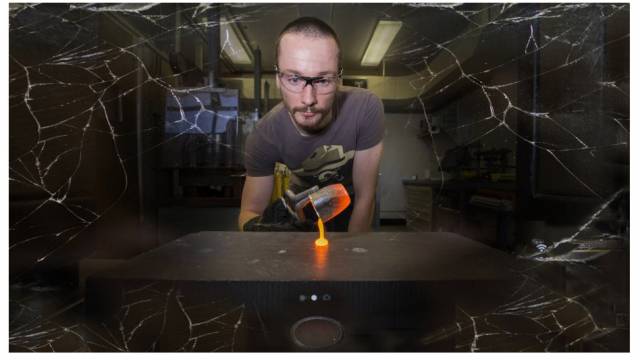Dr Charles Le Losq at the Australian National University
Cracked phone screens could soon be a thing of the past — thanks to ongoing work at the Australian National University science searching for new properties to make glass harder.
Research by the Australian National University (ANU) could soon help lead to the development of shatter-proof glass for mobile phones.
Lead researcher Charles Le Losq said while a particular type of glass, called alumino-silicate, was used in lots of everyday items — such as smartphones — not a lot was actually known about its structure.
Le Losq said he and a small team of researchers added elements such as sodium and potassium to glass, forming a new nano-structure on an atomic level when it was set into a pane.
He said the findings could be used to make glass more flexible and resistant to fractures.
“We inferred that we could use this knowledge to search for new properties and make glass harder,” he said.
“This will require further work of course and will also require some collaboration with the industry.
“Now we can build on this but we’re talking timeframes of maybe five to 10 years.”
Le Losq began his research in 2010 when he was working at the Institut de Physique du Globe de Paris and completed it when he moved to the ANU in Canberra.
He said seven researchers from six universities in Australia, France, the United Kingdom and China worked together on the study.
“The glass structure is still an ongoing problem for the material science community, so it’s very important to do this first step,” he said.
The research builds on longstanding work in the fields of chemistry, material science, physics and geochemistry about how to make smartphone screens stronger, while also ensuring they were resistant to scratches.
Le Losq said his research to date had not examined whether the modified glass he created would also be resistant to scratches, but said future experimentation and tweaking with industry could determine that.
“There is some balance between having something very hard [to resist scratches] and being very brittle [weak to cracking],” he said.
“That’s something that would have to be addressed by future research. We’re not at that stage yet.
“On a very fundamental level we’re playing with two or three atoms, but now we need to extend this vision … to really understand what happens when you add a particular type of atom in the structure of the glass and how that structure of atoms will change the glass’ resistance.”




